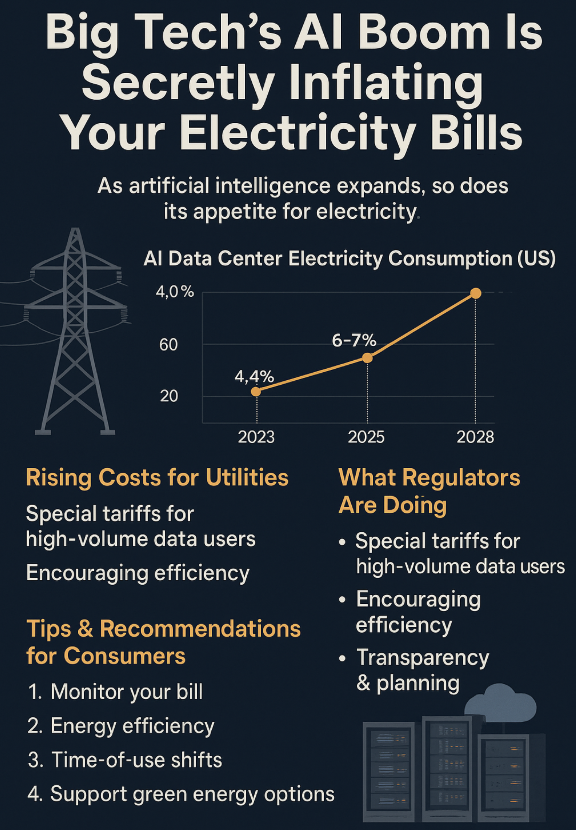
We all love AI. It helps us draft emails, generate code, whip up images and maybe even win a few arguments with our kids over homework. And for many of us, the price tag feels like a steal — maybe $20 a month for a ChatGPT subscription or free when bundled into an app we already use. That feels like small change for a technology that seems to unlock superpowers.
But here’s the part we don’t think about: Your electric bill might already be higher because of AI. Someone has to pay for all the juice these “AI factories” are guzzling, and increasingly, that someone is you.
The Hidden Energy Appetite of AI
According to a recent report from UtilityRates.com, U.S. data centers consumed 4.4% of all electricity in 2023. Let that sink in — nearly one out of every twenty-five kilowatt-hours generated in the country went straight into keeping servers cool and GPUs churning out AI workloads.
And it’s only getting worse. UtilityRates projects that number could triple by 2028 to nearly 13% of the entire U.S. grid load. That’s not just a tech problem. That’s a national infrastructure problem.
To meet this surging demand, utilities are racing to build new power plants, expand transmission lines and upgrade the grid. The estimated price tag? $1.1 trillion by 2029. One way or another, that bill has to be paid — and if history is any guide, consumers will see at least part of it reflected in their monthly statements.
Why Households Should Care
AI data centers are not like the occasional crypto-mining warehouse that pops up in the news. These are sprawling, industrial-scale server farms that run 24/7/365. Unlike your home office or neighborhood coffee shop, they don’t close at night. Their demand is relentless.
That relentless demand is forcing utilities in states like Indiana, Ohio and Virginia to take drastic measures. Some are imposing special tariffs on Big Tech, effectively charging hyperscale operators more to avoid saddling households with the full brunt of new costs.
Still, the line between “industrial costs” and “residential costs” isn’t always as clear as we’d like. Utilities are businesses. Infrastructure is expensive. Rate design is complicated. And when regulators fall behind the curve, consumers tend to make up the difference.
What Regulators are Doing
UtilityRates.com’s report points out that regulators are trying to get ahead of the curve. Among the steps being taken:
- Special Tariffs for Big Tech: Utilities in high-demand states are carving out separate rate categories to prevent households from subsidizing hyperscale usage.
- Efficiency Incentives: Data centers are being nudged to use renewable energy, energy-efficient servers, and on-site storage to reduce grid strain.
- Transparency Mandates: Utilities must forecast AI-driven demand and disclose potential cost impacts on ratepayers.
These efforts are commendable. But like all regulatory frameworks, they are reactive by nature. AI is moving fast — faster than grid planners and public utility commissions can usually keep up with.
What You Can Do as a Consumer
Here’s where it gets personal. Matt Oberle, an energy market specialist at UtilityRates.com, notes:
“AI data centers are the latest example of a technology boom translating into tangible costs for everyday consumers. Large server farms operate nonstop, consuming massive electricity loads that utilities must support through new infrastructure. Without proactive measures, the costs of these upgrades, projected at over $1 trillion by 2029, could cascade into residential electricity bills.”
UtilityRates recommends a handful of steps consumers can take to soften the blow:
- Monitor your bill closely. Know which charges are fixed versus variable.
- Invest in efficiency. Smart thermostats, LED bulbs and appliance timers can trim usage.
- Shift to off-peak hours. Running washers or dishwashers late at night can reduce costs.
- Opt into renewables. Where possible, switch to green-backed tariffs.
- Engage locally. Participate in public utility meetings — make sure residential voices are part of the conversation.
These strategies won’t erase the systemic impact of AI’s energy hunger, but they will help households avoid unnecessary costs while regulators catch up.
Shimmy’s Take
We’ve been conditioned to think of AI’s costs in terms of cloud credits and subscription fees. Twenty bucks a month feels like a bargain for something that can draft a sales pitch or debug code. But that’s just the tip of the iceberg. The real tab is being racked up behind the scenes — in the kilowatts needed to power these massive data centers and the trillion-dollar infrastructure bill utilities are preparing to pass along.
AI’s hidden costs may turn out to be greater than we expect. As we rush headlong into this brave new world of generative assistants and agentic platforms, it’s worth asking: how much are we really willing to pay for convenience and capability?
Because when the next electric bill arrives, don’t be surprised if part of it is quietly underwriting the future of AI.


